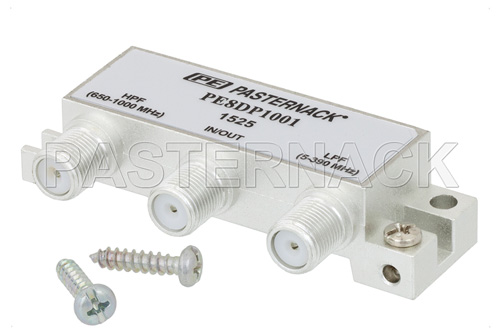 RF Diplexers and Duplexers are very common RF components in transmitters, receiver, and transceiver circuits for communications, radar, and other sensing applications. As the terms are similar, they are sometimes mistakenly used interchangeably, which isn’t appropriate. Diplexers and Duplexers perform very different functions, though they are located in similar areas in a circuit block diagram. This blog will explain the basic functions of Diplexers and Duplexers, and detail the differences in operation.
RF Diplexers and Duplexers are very common RF components in transmitters, receiver, and transceiver circuits for communications, radar, and other sensing applications. As the terms are similar, they are sometimes mistakenly used interchangeably, which isn’t appropriate. Diplexers and Duplexers perform very different functions, though they are located in similar areas in a circuit block diagram. This blog will explain the basic functions of Diplexers and Duplexers, and detail the differences in operation.
Key Takeaways
- A diplexer is a passive three-port device that divides or combines signals based on frequency bands—it allows two different frequency signals to share a common antenna or feedline.
- A duplexer allows a single antenna (or feedline) to be used for both transmitting and receiving, typically at the same or closely spaced frequency, by separating signals based on direction (TX vs RX) and providing isolation.
- The two are not interchangeable: using a diplexer when you need a duplexer (or vice-versa) can lead to insufficient isolation, signal interference, or system failure.
- Diplexers tend to operate with widely separated frequency bands, whereas duplexers must provide high isolation when TX/RX frequencies are close or identical.
- Understanding whether your system requires separation by frequency (diplexer) or simultaneous TX/RX on one antenna (duplexer) is critical for correct RF design and equipment specification.
Diplexer
A diplexer is a 3-port RF device, which enables the use of two signal paths on the same antenna or transmission line. This is done by frequency division using filters, either high-pass, low-pass, or band-pass filters. Hence, signals at two different frequencies could be sent and received from the same antenna. For a diplexer to function well, the quality and attenuation of the filters must scale with how close the signals, what power levels they operate at, and what nonlinearities are expected.
Diplexers are commonly used in telecommunications, where multiple modulation methods and carriers may operate on the same antenna. For example, cellular base stations may need to transmit and receive CDMA, LTE, or GSM signals on the same antenna, as a cell site may have limited availability off tower space for additional antennas.
Duplexer
A duplexer is also a 3-port RF device, and its purpose is to separate transmit and receive signals from an antenna to two different signal paths based on direction. These transmit and receive signals may be operating at the same frequency, and hence a duplexer enables true two-way communication from a single antenna. For example, a duplexer may be used in a radar system were the high power transmitter signals need to be isolated from the sensitive receiver circuitry, but operate on the same antenna.
Either switched systems or magnetic circulators are used to create the isolation between the incoming and outgoing signals within a duplexer. Duplexers are limited by how well they can isolate the receive path from the transmit path, as well as their bandwidth of operation. With radar transmit/receive (TR) modules, the transmit and receive frequencies are typically very close, and can only reasonably be separated through duplexing. Duplexer and circulator is sometimes used interchangeably, which is a common simplification, though not always accurate.
Recommendations
- For systems where two distinct frequency bands share a single antenna (e.g., one for uplink, another for downlink, or for different services), specify a diplexer.
- For systems requiring simultaneous transmit and receive on the same antenna or feedline (full-duplex, radar, repeater systems), specify a duplexer with appropriate isolation ratings.
- Ensure datasheets include the necessary isolation, insertion loss, and frequency band coverage for your chosen component.
- Validate that the shared antenna, connector interfaces and cabling are compatible with the frequency range and power levels of the diplexer/duplexer.
- Work with reputable RF component vendors to ensure reliability, especially in demanding or mission-critical applications.
Diplexer versus Duplexer
Simply put, a duplexer separates a transmit and receive path based on signal direction and can be used for same frequency signals, and a diplexers separates signals based on frequency with filters. Their operation is not interchangeable, and a diplexer could not replace a duplexer in common circuits. Duplexers may become more common in telecommunications applications and future 5G technologies may benefit from having transmit and receive signals at the same frequency for greater spectrum utilization.




 Pasternack Blog
Pasternack Blog
